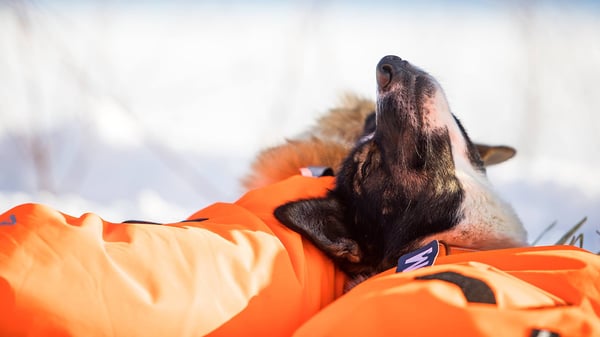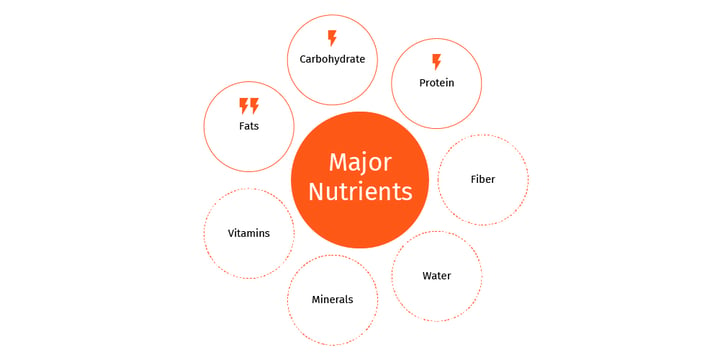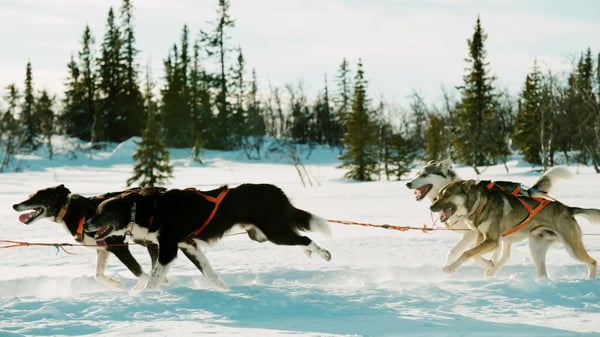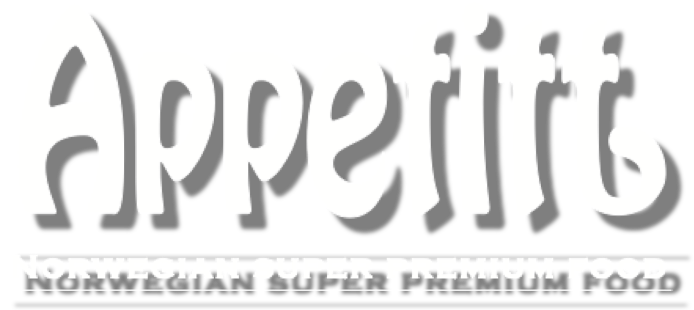We think knowing the basics in nutrition is important for anyone. That’s why we decided to write the following series of articles around the basic nutrition of our best friend, the dog.
Water is crucial, that's why the first article of the series is going to be about what water means for your dog and which are the most important energy sources.
Dogs need to eat to get energy and for building block they can’t make themselves. That’s why each and every ingredient in the dog food plays an important role. Together they should provide all that dogs need to live a healthy and full of energy life.
How important is water for dogs?
Water is crucial. Almost 70% of a dog's body is water, every single body cell relies on it, and losing 15-20 % may result in death. Dogs that work hard, like sled dogs, hunting dogs, search-and-rescue dogs etc., often need more water due to and amongst others:
-
Panting from increased body temperature while working;
-
Water loss from slight diarrhoea caused by stress, etc.
If the dog is not drinking enough water, a loss of just a few percent of body water may negatively affect his or her mental and physical work performance (Otto et al, 2017). The dehydration causes a reduction in blood volume that carries oxygen to working muscles, increases pulse rate and increases core temperature as heat is not transported out from the body with the water. These, in turn, reduces the overall exercise performance capacity and may cause the dog to feel unwell from nausea and stomach disturbances.
Hence, offering water as often as you can, preferably with an added spoon of something tasty, or diluted wet food snacking during the workout is a good idea. The meals can also be served soaked with fluid to secure water intake when resting in between the exercises.
Hence, offering water as often as you can, preferably with an added spoon of something tasty, or diluted wet food snacking during the workout is a good idea. The meals can also be served soaked with fluid to secure water intake when resting in between the exercises.

Note that your dog does not sweat like a human. Humans sweat through glands located over larger areas of the skin causing loss of both water and electrolytes, while the dog only sweats through panting and some minor sweat gland in their paws.
Therefore, dogs lose less water volumes but also much less electrolytes. Salt supplement in working dogs has mostly seem to be unnecessary, except when sled dog races take more than 10 days (Hinchcliff et al., 1997, Ermon et al., 2014). Electrolyte in small quantities may still be beneficial for exercising dogs in hot and humid climate, but caution should be taken as salt overload can be toxic. More research is needed on this topic.
Other major nutrients
Moving on to nutrients that provides energy or work as building blocks or catalysts, these are the major groups your dog needs to survive:

Do you know why there are two lightnings above fats, but only one above carbohydrate and protein? And nothing above the remaining nutrients? Well, the lightnings indicate that those nutrients can provide energy to dogs. And 2 lightnings above fat means fat provides 2 times the energy per gram (9 kcals per g) compared to carbohydrate or protein (4 kcals per gram). And fibre does not provide any energy to speak of, nor do vitamins and minerals.
The dog is actually particularly good at utilizing fats as energy during exercise, and is not at all as carbohydrate-dependent as humans. Still, both are needed in a balance, as the brain in particular fuels on carbohydrate (glucose).
Dogs are omnivores, not true carnivores, although they have several carnivore traits, and can therefore utilize carbohydrates well. Proteins may also provide energy, however, this should not be their primary task.
Let's have a closer look at the three energy-providing nutrients
Proteins
First and foremost, they are building blocks for the dog's body. Dietary protein consists of many small amino acids put together into longer chains called proteins. There are many different amino acids, and dogs can make many of them. But 10 of them have to come through a diet, as the dog is not able to produce them. Hence, we call them essential amino acids.
Proteins are responsible for building the whole body; skin, bone, ligaments, muscle, blood, and even hormones. Without them, the dog can quickly die. Proteins consists of more than 20 different amino acids put together in chains of various lengths. As said before, many of these amino acids can be synthesized by the dog itself. 10 must be acquired from the diet, and this makes them essential. They are Arginine, Methionine, Histidine, Phenylalanine, Isoleucine, Threonine, Leucine, Tryptophan, Lysine and Valine.
Once enough protein from the diet has been used for building, the remaining excess will be converted into other nutrients in the body. While doing that, the body cuts off a part of the amino acid that contains nitrogen. This part should mostly be excreted out through the kidneys and then the urine, as too much of this in the body may be harmful.
Hence, overfeeding your dog with more proteins than he or she needs for body building is both expensive (as protein is a costly raw material) and might also be a strain on the dog's body.
Proteins are responsible for building the whole body; skin, bone, ligaments, muscle, blood, and even hormones. Without them, the dog can quickly die. Proteins consists of more than 20 different amino acids put together in chains of various lengths. As said before, many of these amino acids can be synthesized by the dog itself. 10 must be acquired from the diet, and this makes them essential. They are Arginine, Methionine, Histidine, Phenylalanine, Isoleucine, Threonine, Leucine, Tryptophan, Lysine and Valine.
Once enough protein from the diet has been used for building, the remaining excess will be converted into other nutrients in the body. While doing that, the body cuts off a part of the amino acid that contains nitrogen. This part should mostly be excreted out through the kidneys and then the urine, as too much of this in the body may be harmful.
Hence, overfeeding your dog with more proteins than he or she needs for body building is both expensive (as protein is a costly raw material) and might also be a strain on the dog's body.

Fats
Fats have several tasks in the body, and one of their primary tasks is to provide energy. Burning 1 gram of fat gives twice the energy compared to 1 gram of carbohydrate or 1 gram of protein, hence it is an efficient and concentrated energy source.
Dogs are particularly good at utilizing fat as energy when the workload is performed as aerobic exercise (moderate intensity with oxygen present in the muscles). Fats are an important building material in all cell membranes for the entire body, transporting fat-soluble vitamins and building hormones. So, no fat – no cells, vitamin transport or hormones – no dog-life.
There are many different fats that are important for the body but two of them have to be provided through diet as they cannot be synthesised by the dog. These are the omega-3 fatty acid alpha-linolenic acid or EPA/DHA, and the omega 6 fatty acid linoleic acid, and they are essential for dogs.
Dogs are particularly good at utilizing fat as energy when the workload is performed as aerobic exercise (moderate intensity with oxygen present in the muscles). Fats are an important building material in all cell membranes for the entire body, transporting fat-soluble vitamins and building hormones. So, no fat – no cells, vitamin transport or hormones – no dog-life.
There are many different fats that are important for the body but two of them have to be provided through diet as they cannot be synthesised by the dog. These are the omega-3 fatty acid alpha-linolenic acid or EPA/DHA, and the omega 6 fatty acid linoleic acid, and they are essential for dogs.
READ MORE: THE HEALTH BENEFITS OF KRILL
Carbohydrates
They serve mainly as a source of energy. Carbohydrates may vary from short to complex and long. The longer they are, the longer it takes to break down for absorption and vice versa. The longest ones are called fibres and are only partly or not at all digestible. The shortest one is called glucose and is highly digestible and important for quick and short-term energy for most body cells.
Like in humans, the dog's blood contains certain levels of this particular sugar, and the liver stores glucose in form of glycogen (small amounts can be found in muscles as well).
Whenever the dog needs energy, he or she will burn the short sugar in the blood and the liver will convert glycogen into glucose, releasing it into the blood stream to keep the level steady. However, this storage does not last for very long, and once used up the body starts burning fat for energy instead. The dog then needs to eat carbohydrates to refill its glucose-storage.
By providing more complex carbohydrates in the food, the dog will be able to break down the longer chains into glucose over time and have a continuous glucose re-fill for the body cells.
Some might think the dog doesn’t need carbohydrates in the diet, and this is partly true. But the only fuel for a dog’s brain is glucose. Hypoglycemia, lack of enough glucose to the brain, can cause damage beyond repair. By not feeding them carbohydrates, proteins inside the body must instead be converted to glucose (gluconeogenesis). This is an energy-costly and not equally efficient way to glucose.
Therefore, since glucose is easiest retrieved from carbohydrate, it is a good choice to have at least a minimum of carbohydrates in the dog’s diet.
Like in humans, the dog's blood contains certain levels of this particular sugar, and the liver stores glucose in form of glycogen (small amounts can be found in muscles as well).
Whenever the dog needs energy, he or she will burn the short sugar in the blood and the liver will convert glycogen into glucose, releasing it into the blood stream to keep the level steady. However, this storage does not last for very long, and once used up the body starts burning fat for energy instead. The dog then needs to eat carbohydrates to refill its glucose-storage.
By providing more complex carbohydrates in the food, the dog will be able to break down the longer chains into glucose over time and have a continuous glucose re-fill for the body cells.
Some might think the dog doesn’t need carbohydrates in the diet, and this is partly true. But the only fuel for a dog’s brain is glucose. Hypoglycemia, lack of enough glucose to the brain, can cause damage beyond repair. By not feeding them carbohydrates, proteins inside the body must instead be converted to glucose (gluconeogenesis). This is an energy-costly and not equally efficient way to glucose.
Therefore, since glucose is easiest retrieved from carbohydrate, it is a good choice to have at least a minimum of carbohydrates in the dog’s diet.
A formulated dog food normally provides energy from all these three nutrients in a blend. The ration between them varies with the needs of the dog based on life stage and activity level.



.png)